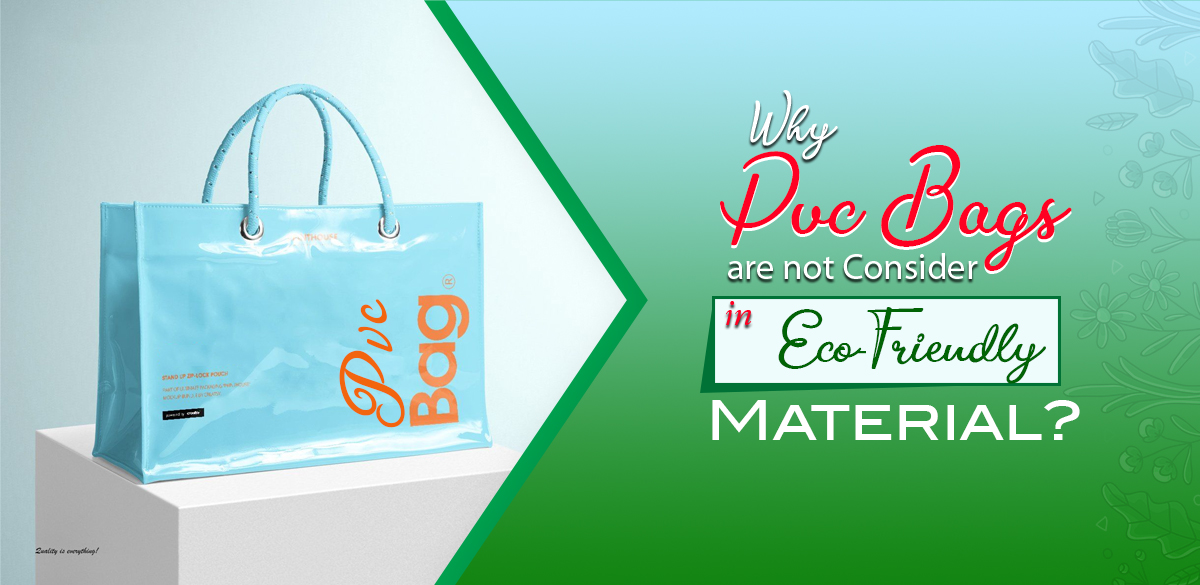PVC bags are now widely in circulation and are attributed as a safe alternative to previously used plastic bags. These sacks are manufactured of polyvinyl chloride and are said to be eco-friendly and biodegradable, but the fact is that they are not as safe alternatives as assumed. Chlorine is the main building block in this material, which is highly dangerous in nature and can result in severe mutilation in marine and wildlife. The recycling process of these bags also requires different sorts of heavy metals like lead and cadmium, which can contaminate natural water sources. There is always a need for consideration on the wide use of such material in daily life products.
Polyvinyl chloride, better known as PVC, is the most utilized form of plastic used in the packaging industry. This material is preferred over the traditional plastics due to the recyclable nature of the materials. It is highly effective in keeping the products safe from external contaminations as the material is waterproof, can resist heat and sunlight, can work as a perfect barrier for oxygen by keeping it out of the package, and can also resist fire. Due to these unique qualities, this material is widely used in the packaging of sensitive items such as medicines and food packaging. PVC Bags are also widely in circulation for packaging of different items and one of the most utilized alternatives for traditionally used plastic bags, which resulted in high emissions and an increase in the plastic waste on the planet.
The use of PVC is also common in other industries, such as the fashion industry, as a number of unique designer PVC bags are common. Tote sacks are one of the most common in the industry as these bags are highly customizable and can also be printed in high-quality graphics to elevate the appeal. These bags are now like a fashion statement in the industry as everyone is allured for such designs. The audience mainly thinks that PVC is 100% biodegradable, but the fact is not totally true as there are many forms of material that differ in qualities. Some of the forms of materials are biodegradable and sustainable in nature, while others don’t degrade. The form of material used in the PVC tote bags is not biodegradable as it is thick in the construction, and the use of different oil-based chemicals in the material results in the negative nature of the material.
PVC is made up of long chains of polymers that are effective in enhancing the recyclability of the material. It is thought that the material can be recycled 7 times in average life span and thus is eco-friendly in nature, but this fact is not true as there are many forms of PVC, some of which are not biodegradable. The recycling of the materials also requires different additives such as heavy metals as catalysts in the process; these materials are negative for the environment as they result in contamination of water, making it poisons. Any mishandling in the process can be led to lead poisoning, which directly affects the human brain. Here are some of the reasons why PVC is not as eco-friendly as it is thought to be.
Presence of Chloride:
Chlorine is the main building block in the production of PVC, and according to research, about 40% of all chlorine production in the world goes to the manufacturing of this polyvinyl chloride. Chlorine is the most hazardous material and is infamous for use in chemical weapons, which were lethal in nature and killed millions in World War 2. Moreover, it is also one of the biggest contributors to chlorofluorocarbon gases, which are the main reason for the destruction of the ozone layer. Due to the increased use of PVC products such as clear PVC bags, the chlorine-based toxicants are building up in the air, water sources, and food items. Bags manufactured of PVC are also widely used in the packaging of food items, and it can result in contamination of the edibles.
Negative Impact on Wildlife:
The increased use of polyvinyl chloride has also led to one of the biggest concerns relating to the safety of wildlife and marine species. The carbon-based toxicants are in the size of microbes and can easily penetrate the surface soil on the earth and contaminate the natural water sources. It can badly impact the water reserves and ultimately can result in the mutilated birth of marine life. Moreover, the chemical structure of organochlorine chains presents in the food sources and plants has a negative impact on the growth of animals, making them unable to expel from their bodies. The contamination levels are thousands of times higher than what is found in the surrounding environment, and the impact is that high that it impacts the organs even before birth.
Recyclability:
It is widely thought that polyvinyl chloride is highly biodegradable and can be recycled easily. The fact is true to some point but not fully true. There are a number of different PVC polymers, some of which are recyclable, but the process of recycling is more toxic than expected. The long chains of chloride prove to be beneficial in recycling, but they require a different form of additives to work as a catalyst in the process of recycling. Different sorts of heavy metals such as cadmium and lead are added to the shredded polyvinyl chloride pieces for the process of recycling. These heavy metals are damaging in nature and can impact on the nervous system of humans along with resulting difficulties in the respiratory system of human bodies. Moreover, only 1 percent of all Custom PVC Bags are recycled.
Conclusion:
After all the considerations, we can say that the increased use of polyvinyl chloride in the packaging and fashion industry is not good for the environment. PVC can be said a safe alternative to the traditionally used styles of plastics in the industry, but it is itself not as safe as we assume. Extensive use of PVC can result in the contamination concerns related to damaging natural resources and high risks of lead and heavy metal poisoning. The presence of chlorine in the materials is also bad for human health, and the low level of recycling of materials can also be added in its low eco-friendly nature.






